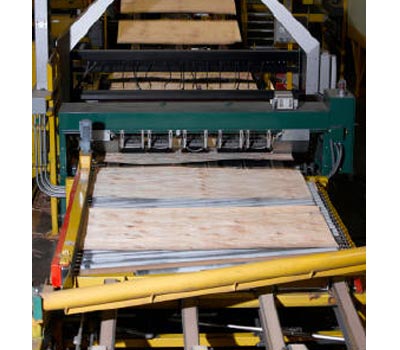Roseburg Forest Products (RFP) is the largest player in the west coast veneer and plywood business. Roseburg’s veneer-based business is comprised of four Oregon mills (Riddle Plywood, Riddle EWP, Coquille Plywood, and Dillard Plywood) plus the Weed Veneer mill in Northern California. All the mills are located within an 80 mile radius. All mills have the ability to ship veneer to other Roseburg facilities as well as to outside customers; in addition, RFP supplements internal veneer production with purchased veneer from a number of outside sources.
The business utilizes softwood veneer in several species including: Douglas-fir, Hemlock, White fir and Pine as well as a number of hardwood and decorative veneers. Softwood veneer lengths range from 8’ to 10’, widths range from 4’ to 5’ and thicknesses range from 1/10” to 7/32”. RFP makes a very broad range of plywood products including traditional siding, sanded, sheathing, underlayment, concrete form as well as many specialty items including hardwood overlay panels. RFP also makes quality LVL and I-Joist products in the EWP plant at Riddle.
Leadership
Steve Killgore, recently promoted Vice President of Solid Wood for Roseburg Forest Products, played a significant role in bringing profit optimization technology into the company along with Plywood Business Director Pat Lynch, Manufacturing Director Bob Jewell, Plant Manager Ted Downs and Division Controller Mike Carr. Killgore had a very positive experience with Optware Solutions when he managed McKenzie Forest Products in Springfield, Oregon before joining the Roseburg team. In his prior experience, Steve developed a strong appreciation for the complexities of the plywood manufacturing business and how optimization brings value. Steve understands that traditional spreadsheet solutions and cost accounting fall far short of what is needed for optimized profit guidance; adding linear programming to the tool kit ensures that product mix (and the related impacts on revenue and costs) is fully considered.
There are different philosophies about how to run a mill: Some operators focus on recovery, some emphasize production volume, and others focus on sales realization. At the end of the day, profit maximization must be the key objective. RFP recognizes that optimization modeling is an essential tool to help managers find the best possible blend of business variables.
Objectives
Roseburg’s multi-mill environment and shared wood supply included many complexities. The management team hoped to answer the following questions:
- Are we making the optimum product mix to maximize profitability?
- Can we streamline product mix and reduce changeovers and reduce inventories?
- Can we better utilize veneer better to improve recovery?
- Are we producing the best combination of peels?
- Are we spending too much effort moving veneers between plants?
- Are we manufacturing panels and veneers at the most efficient mill?
Optware Solutions kicked off the linear programming project in the spring of 2013. Project coordinators from each manufacturing plant were selected to collect data for the Optimization System. Optware consultants worked with Roseburg staff to determine the depth and quality of data systems including the JD Edwards ERP system (E1). The objective was to obtain the best planning data possible. While it became apparent early-on that there were a lack of comprehensive data systems at the mills and a lack of standardization in the process, the project team was able to glean adequate data for the initial modeling. Roseburg now has several efforts underway to address ongoing data quality and to improve compatibility across various data systems.
Implementation
In early 2014, Andreas Buers took charge of optimization at Roseburg’s Solid Wood Division to guide the initial implementation efforts. Early optimization results demonstrated that selected panels were not constructed in the optimum manner. The management team reviewed peels and panel constructions in a more comprehensive manner to ensure that best practices are used across the company. A good bit of effort was also spent in streamlining the product mix to gain production efficiencies and reduce inventories.
Andreas says, “Roseburg operates in the highest priced log market in the USA. We use the Optware System like a compass pointing out areas of opportunity. Changes to peels and constructions as well as streamlining product mix will bring significant cost savings to the company. We still have some opportunity to reduce freight costs and gain manufacturing efficiencies related to the allocation of orders between mills. We also need to expand our understanding related to the leverage of product mix.”
Each week, Buers and recent hire, Linear-Program Manager Jim Ployhar, work with the Roseburg team to complete a cycle of updating market pricing, production rates and order information. Given the seasonality of the plywood markets, the order file sometimes does not reach full production levels. The Optware System is then used to determine order placement as well as the target product mix that complements orders, resources, and market realities. Buers comments: “ Our focus is profitability not production”.
Moving forward, RFP expects to expand the use of the Optware System to direct the wood procurement effort for logs in addition to its current use for veneer planning. It is important to get the right log to the right mill at the right time for the right peel. The business has a lot of moving parts. The majority of the veneer is peeled inhouse; a portion of veneer is purchased outside of the company and there is a lot of interplant veneer flow. The Optware System is very beneficial in managing the ripple effects.
Buers is pleased with the progress Roseburg has made implementing the Optware System, but wants his team to keep pushing forward. “We’ve made some great strides in focusing our veneer and product mix strategy. I’m encouraged by the fact that procurement, production and sales are experiencing a much greater level of cooperation. We now have a tool that can effectively communicate the consequences of various operating strategies.”

Contact Optware today to schedule a consultation
503-645-2390 | info@optware.com



